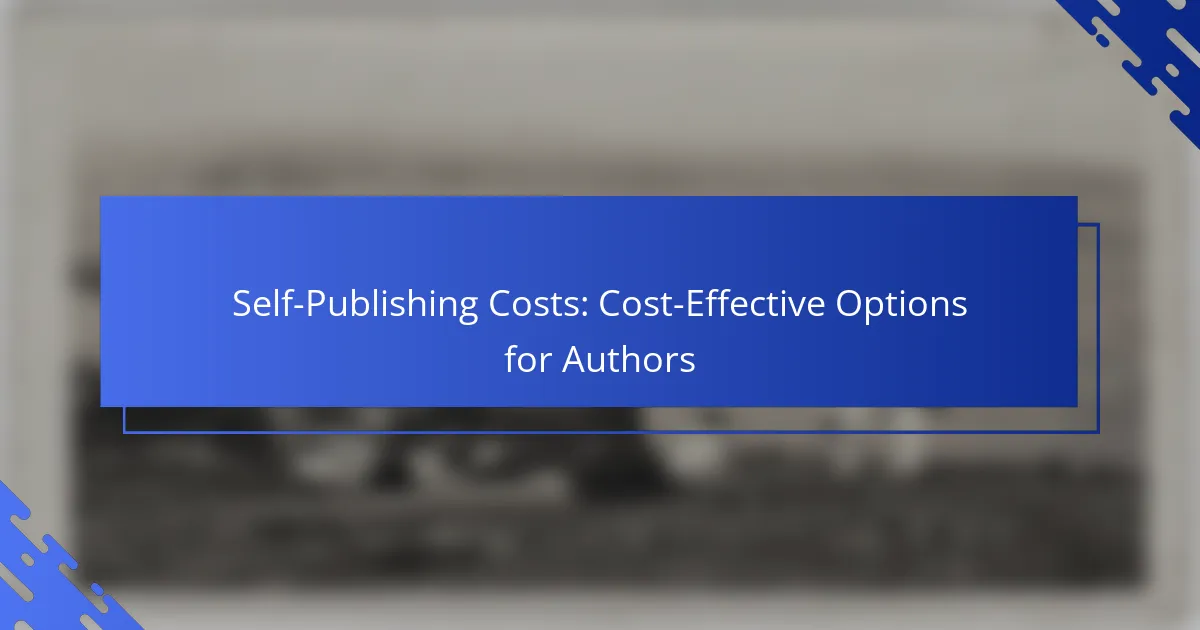Self-publishing offers authors the opportunity to bring their work to market, but it comes with various costs that must be carefully managed. Key expenses such as editing, cover design, and marketing can significantly influence the success of a book. Fortunately, there are cost-effective options available, including free platforms and DIY tools, that enable authors to publish their work without breaking the bank.
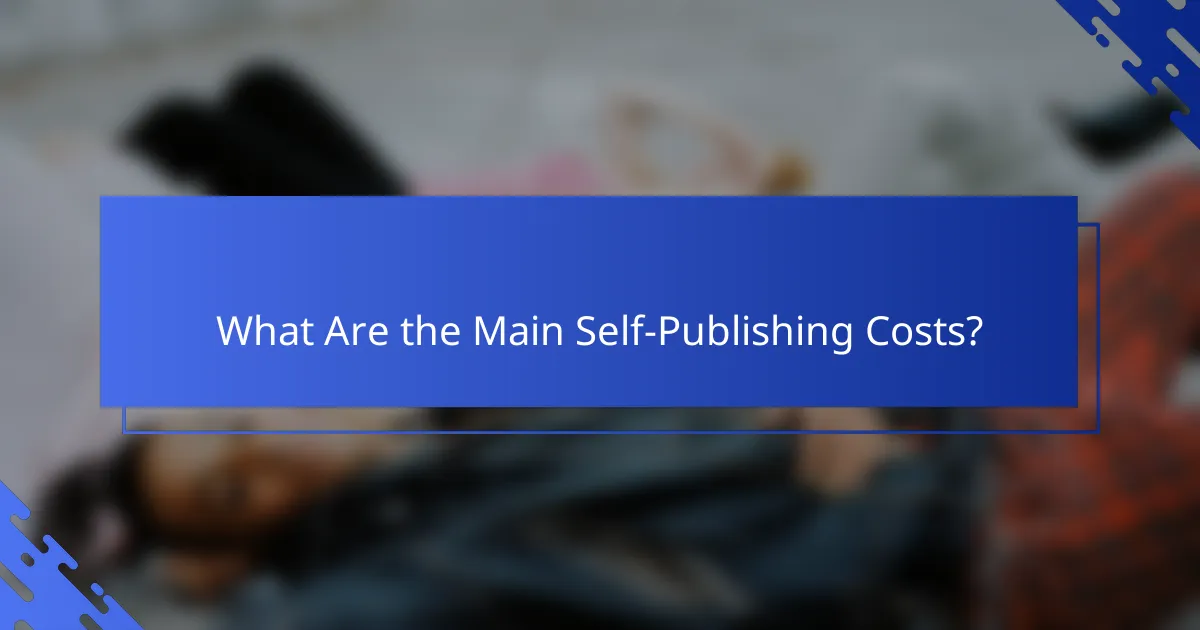
What Are the Main Self-Publishing Costs?
Self-publishing involves various costs that authors should consider to ensure a successful launch. Key expenses typically include editing, cover design, formatting, distribution, and marketing, each of which can significantly impact the overall quality and reach of the book.
Editing and Proofreading Expenses
Editing and proofreading are crucial for producing a polished manuscript. Authors can expect to pay anywhere from a few hundred to several thousand dollars, depending on the level of editing required—developmental, copyediting, or proofreading. It’s advisable to invest in professional services to enhance clarity and coherence.
Many authors choose to hire freelance editors or editing services. Before committing, request samples and compare rates to find a balance between quality and budget. Avoid common pitfalls like skipping this step, as errors can detract from reader experience.
Cover Design Costs
A compelling cover design is essential for attracting readers. Professional cover design costs can range from $100 to over $1,000, influenced by the designer’s experience and the complexity of the artwork. Investing in a quality cover can significantly impact sales.
When selecting a designer, review their portfolio to ensure their style aligns with your genre. Consider using platforms like 99designs or Fiverr for budget-friendly options, but be cautious of compromising on quality.
Formatting Fees
Proper formatting is necessary for both print and digital versions of your book. Costs for formatting services can vary from $50 to several hundred dollars, depending on the complexity of the layout and the number of formats required. DIY formatting is an option, but it requires time and technical skills.
Tools like Scrivener or Vellum can help authors format their books independently. However, if you choose to hire a professional, ensure they are familiar with the specific requirements of platforms like Amazon Kindle or IngramSpark.
Distribution Charges
Distribution costs can affect how widely your book reaches readers. Many self-publishing platforms charge fees or take a percentage of sales. For instance, Amazon typically takes around 30% of the royalties for eBooks priced between $2.99 and $9.99.
Authors should research various distribution options, including aggregators like Draft2Digital or Smashwords, which can simplify the process but may also take a cut of earnings. Weigh the benefits of broader reach against the costs involved.
Marketing and Promotion Budgets
Marketing and promotion are vital for gaining visibility in a crowded market. Budgets can vary widely, from a few hundred dollars for basic online advertising to thousands for comprehensive campaigns involving social media, book signings, or promotional services.
Consider starting with low-cost strategies such as social media marketing or building an author website. Track your spending and return on investment to optimize your marketing efforts. Avoid overspending on unproven tactics without assessing their effectiveness first.
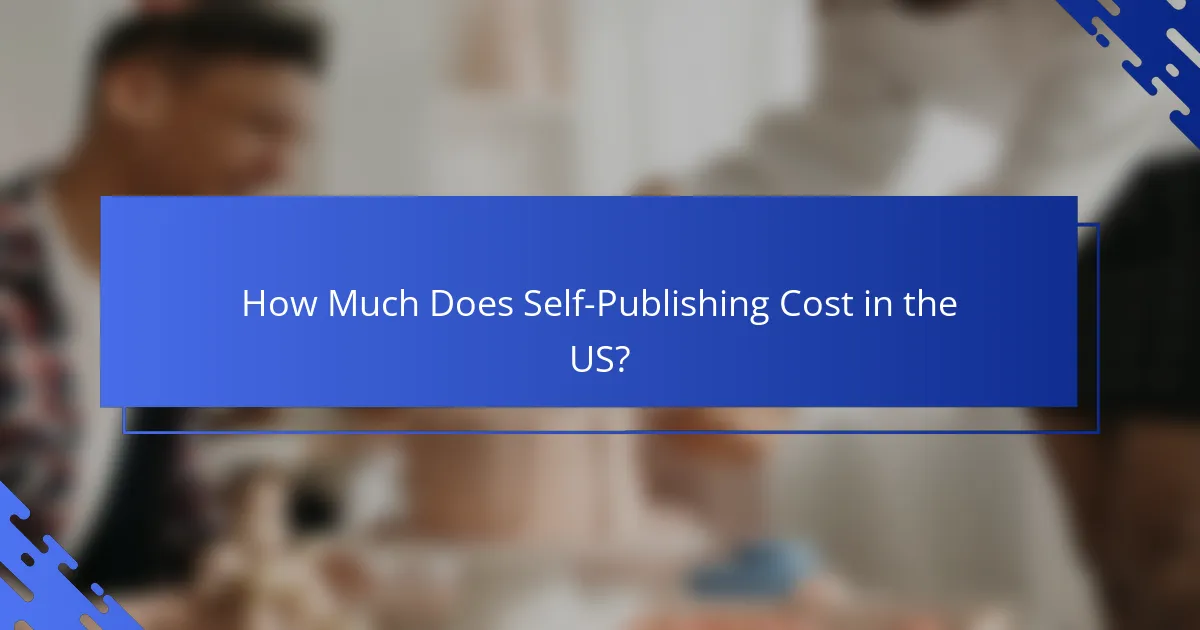
How Much Does Self-Publishing Cost in the US?
Self-publishing costs in the US can vary widely, typically ranging from a few hundred to several thousand dollars depending on the services you choose. Key expenses include editing, cover design, and formatting, each of which plays a crucial role in the quality of your final product.
Average Editing Costs
Editing is one of the most significant expenses in self-publishing, with costs generally falling between $500 and $3,000. This range depends on the type of editing required, such as developmental editing, copy editing, or proofreading.
For example, developmental editing, which focuses on the structure and content of your manuscript, tends to be more expensive than proofreading, which is primarily concerned with grammar and punctuation. Authors should budget accordingly and consider the value of professional editing in enhancing their book’s quality.
Typical Cover Design Prices
Cover design prices can vary significantly, typically ranging from $100 to $2,000. A professional cover is essential for attracting readers and can greatly influence sales.
While you can find affordable options, such as pre-made covers for under $200, investing in a custom design can yield better results. Look for designers with a strong portfolio and experience in your genre to ensure your cover stands out.
Formatting Cost Estimates
Formatting costs for self-publishing usually range from $50 to $500, depending on the complexity and the format required (eBook vs. print). Proper formatting is crucial for ensuring your book meets industry standards and looks professional.
Many authors choose to use formatting software or hire freelancers to handle this task. It’s important to compare options and read reviews to find a reliable formatter who can deliver a polished final product.
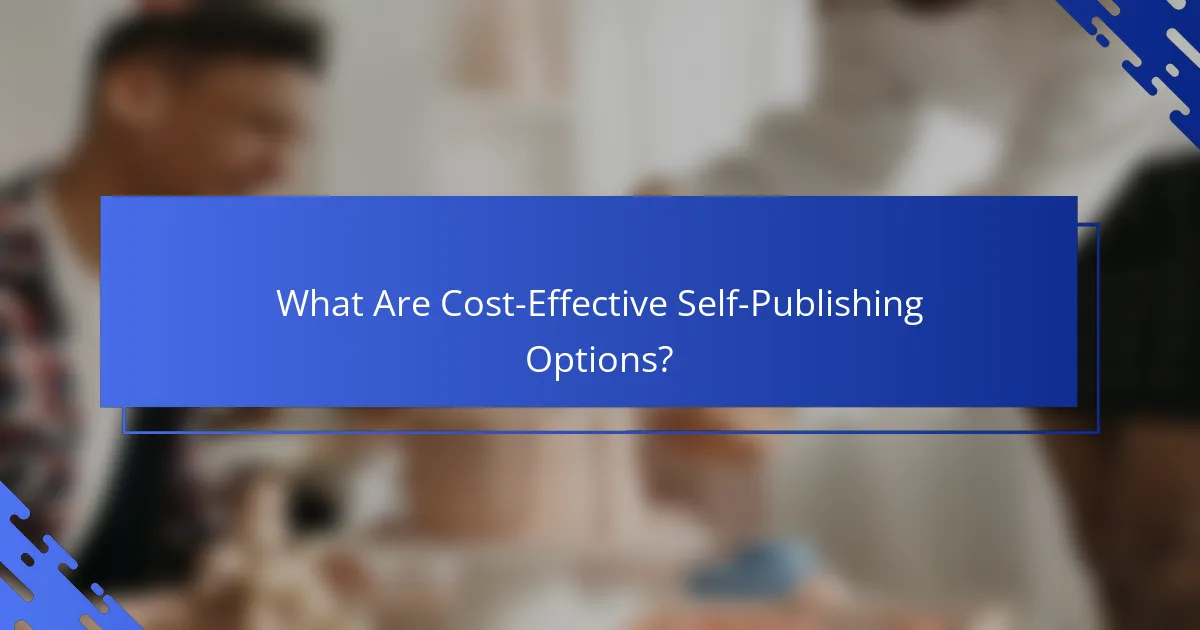
What Are Cost-Effective Self-Publishing Options?
Cost-effective self-publishing options allow authors to publish their work without incurring significant expenses. By utilizing free platforms, print-on-demand services, and DIY tools, writers can manage their budgets while still producing quality books.
Using Free Publishing Platforms
Free publishing platforms like Amazon Kindle Direct Publishing (KDP), Smashwords, and Draft2Digital enable authors to publish eBooks and print books at no upfront cost. These platforms typically take a percentage of sales, making them accessible for authors who want to minimize initial investments.
When choosing a platform, consider the distribution channels and royalty rates. For instance, KDP offers up to 70% royalties on eBooks priced between $2.99 and $9.99, while Smashwords provides access to multiple retailers. Researching each platform’s terms can help you select the best fit for your goals.
Leveraging Print-on-Demand Services
Print-on-demand (POD) services, such as IngramSpark and CreateSpace, allow authors to print copies of their books as orders come in, eliminating the need for large print runs. This model reduces upfront costs and storage issues, making it ideal for self-publishers.
While POD services charge per book printed, authors can set their retail prices to cover costs and earn royalties. It’s essential to factor in printing costs when pricing your book to ensure profitability. Additionally, consider the quality of printing and shipping times when selecting a POD provider.
DIY Editing and Design Tools
Authors can save money by using DIY editing and design tools, such as Grammarly for proofreading and Canva for cover design. These tools offer user-friendly interfaces that enable writers to enhance their manuscripts and create appealing book covers without hiring professionals.
However, while DIY options can be cost-effective, they require time and effort. Authors should be aware of their limitations and consider investing in professional services for critical tasks like developmental editing or cover design if their budget allows. Balancing DIY efforts with professional help can lead to a polished final product.
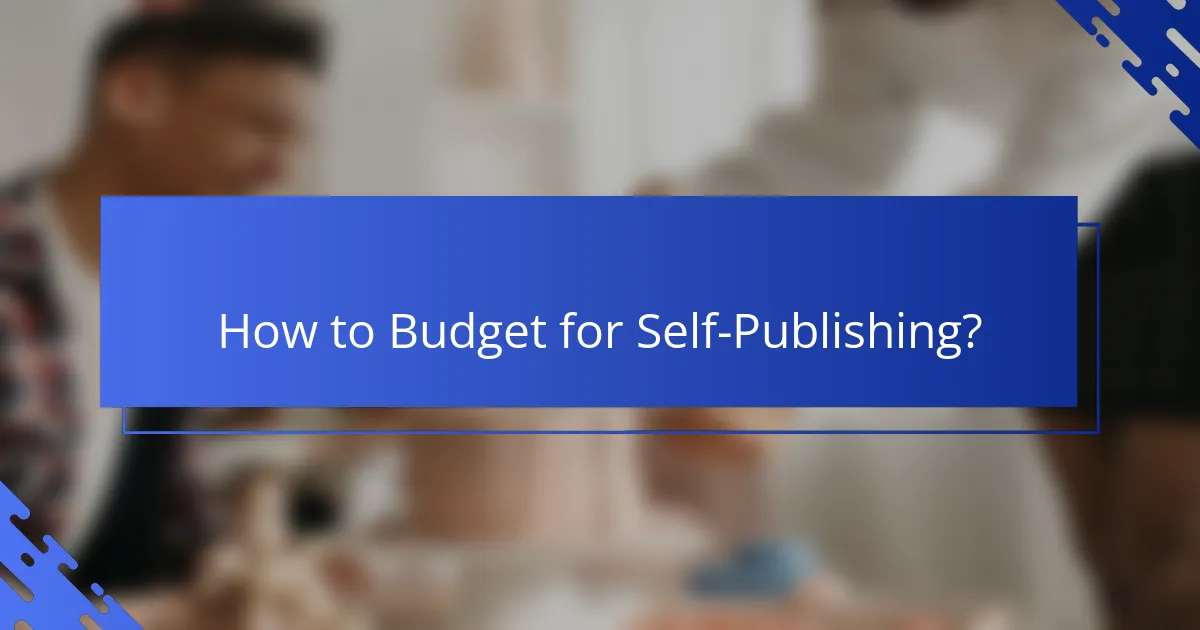
How to Budget for Self-Publishing?
Budgeting for self-publishing involves understanding the various costs associated with the process and planning accordingly. By creating a detailed budget, authors can allocate funds effectively and avoid unexpected expenses.
Creating a Detailed Budget Plan
Start by listing all potential expenses related to self-publishing, including editing, cover design, formatting, and marketing. A detailed budget plan should categorize these costs into fixed and variable expenses, allowing for better tracking and adjustments as needed.
Consider using a spreadsheet to manage your budget. This can help you visualize your spending and make it easier to update as you receive quotes or make purchases. Aim to set aside a contingency fund, typically around 10-15% of your total budget, to cover unforeseen costs.
Identifying Essential vs. Optional Costs
Essential costs are those that are necessary for producing a quality book, such as professional editing and cover design. These expenses directly impact the book’s marketability and should be prioritized in your budget.
Optional costs may include additional marketing services, premium printing options, or advanced promotional strategies. While these can enhance your book’s visibility, they are not strictly necessary for publication. Evaluate each optional expense carefully to determine its potential return on investment before including it in your budget.

What Are the Benefits of Self-Publishing?
Self-publishing offers authors significant advantages, including greater financial returns and enhanced creative freedom. By bypassing traditional publishing routes, writers can retain control over their work and profits.
Higher Royalties Compared to Traditional Publishing
Self-published authors typically earn higher royalties than those who go through traditional publishing houses. While traditional publishers may offer royalties around 10-15% of book sales, self-published authors can retain 60-80% of their earnings, depending on the platform used.
For instance, platforms like Amazon Kindle Direct Publishing (KDP) allow authors to set their own prices and receive up to 70% royalties on eBook sales. This financial model can significantly boost an author’s income, especially for those with a strong marketing strategy.
Creative Control Over Content
Self-publishing grants authors complete creative control over their work, from the manuscript to the cover design. This autonomy allows writers to express their vision without interference from editors or publishers.
Authors can choose their own formatting, cover art, and marketing strategies, ensuring that the final product aligns with their artistic intent. This level of control can lead to a more authentic representation of the author’s voice and message.
Faster Time to Market
Self-publishing enables authors to bring their books to market much faster than traditional publishing, which can take several months or even years. With self-publishing, the timeline can be reduced to a matter of weeks.
Once the manuscript is ready, authors can upload their work to platforms like KDP or IngramSpark and make it available for sale almost immediately. This rapid turnaround is particularly beneficial for authors looking to capitalize on trends or timely topics.
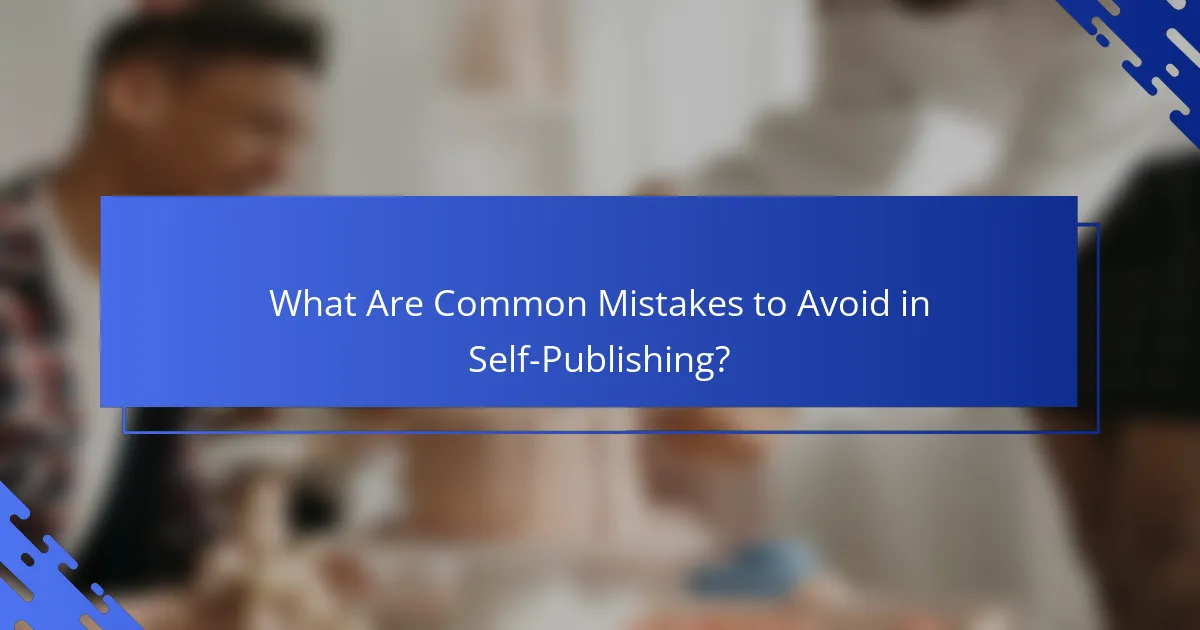
What Are Common Mistakes to Avoid in Self-Publishing?
Authors often overlook key pitfalls in self-publishing that can impact their success. Understanding these mistakes can help you navigate the process more effectively and save time and money.
Underestimating Costs
Many authors fail to accurately estimate the costs associated with self-publishing, leading to budget overruns. It’s essential to consider various expenses, including editing, cover design, formatting, and marketing.
For instance, professional editing can range from a few hundred to several thousand dollars, depending on the manuscript’s length and complexity. Cover design may cost between $100 and $1,000, while marketing efforts can vary widely based on your strategy.
To avoid underestimating costs, create a detailed budget that includes all potential expenses. Research industry standards and seek quotes from professionals to get a clearer picture of what to expect.
